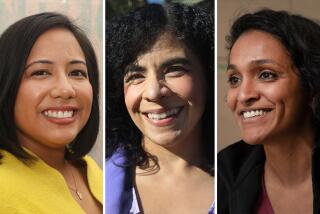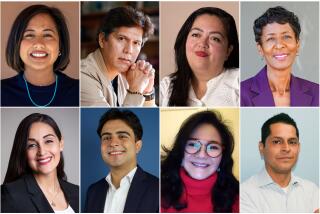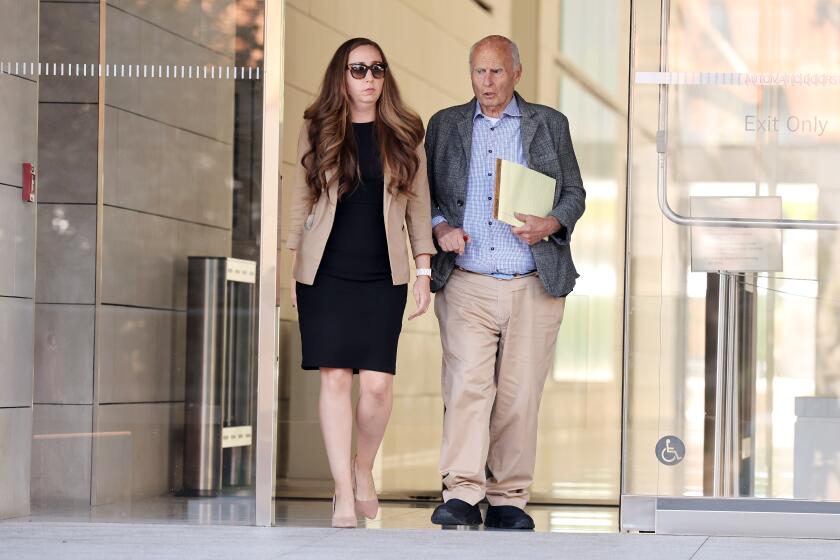Newton: The city that could be
- Share via
Over the last couple of weeks, I’ve spent considerable time with the leading candidates for mayor, asking them about their approach to governance, watching them campaign and trying to get a feel for what distinguishes each from the others.
Specifically, I was interested in their visions for the city, their approaches to campaign funding, their leadership and management abilities, and their strategies for winning the election. Over the next few days, my columns on those subjects will appear. Today’s looks at vision.
Here’s the initial question I put to the four leading candidates — Eric Garcetti, Wendy Greuel, Kevin James and Jan Perry: “Imagine it’s 2021. You’ve been mayor for eight years. How does Los Angeles look different as a result of your work?”
JIM NEWTON: The L.A. mayor’s race
All four were smart enough to add nuance to the question: Los Angeles, with its many diverse neighborhoods, defies a single vision. They all agree, then, on the bottom line: Los Angeles is and will continue to be defined by the distinctiveness of its neighborhoods.
Beyond that, though, there were many differences in their approaches, and those differences reflect deeper distinctions among these candidates.
James campaigns on specifics, and this area was no exception. His future Los Angeles, he said, would feature more people on foot and on bikes, more underground parking with green space on top, less graffiti, smoother sidewalks, a train to the airport, protection for historic buildings and manhole covers that are level with the street. He imagines downtown continuing to rise, attracting more residents and businesses, but he resists embracing “transit-oriented development,” a darling of Garcetti and others, as a panacea.
VIDEO: Interviews with L.A.’s mayoral candidates
Most important, though, James, the one Republican of the four, imagines a future shaped by solving budget problems, in part by eliminating impediments to business growth. His ultimate goal? “There will be far fewer ‘Space Available’ signs,” he said.
Garcetti’s vision is more philosophical than physical. The former council president, whose district includes dense areas such as Hollywood but also leafy Atwater Village and Silver Lake, believes strongly in communities deciding issues for themselves.
“I don’t think you can ever force something down a neighborhood’s throat,” he said. Intense arguments over zoning or planning, he added, are usually “the result of laziness,” of not taking the time to hear out residents and others.
That goes a long way toward explaining Garcetti. Government, in his view, can’t be separate from the people governed, and serves in part by helping neighbors work through arguments. The Los Angeles of Garcetti’s vision eight years from now would almost certainly have greater density around transit, for instance, but only because communities had debated and embraced it.
Greuel’s 2021 Los Angeles sounds something like James’, if slightly less detailed. There would be better public transit; downtown would continue to grow; there would be more places to walk and bike; the city would be greener. All of which is manifestly Greuel: practical, methodical, a little vague, neither too threatening nor too ambitious.
She views government’s role as starting the planning conversation and then serving as an honest broker among disparate interests.
If Perry were to have eight years as mayor of Los Angeles, she says, the city would be cleaner and more creative at the end of it. Graffiti would be less prevalent, pocket parks more common, streetscapes better organized and parking more conveniently located for housing. The elements of that vision speak in part to Perry’s immersion in the fine points of development, which undergirds much of her rhetoric.
Her deputy Marie Rumsey says Perry will consider any idea that promises neighborhood improvement. “She never starts with no.”
Some see her, though, as favoring developers. In the case of a controversial Fresh & Easy market, for instance, Perry opposed a proposal that would have required the market to pay its workers a living wage in exchange for government subsidies. Madeline Janis, Perry’s principal foe in that debate, accused the councilwoman of favoring the developer over her constituents. Rumsey describes the difference as one of “idealism versus practicality.”
It may be tempting to dismiss the importance of a mayor’s physical vision for Los Angeles. But imagination matters, as L.A.’s history well attests. Rear Adm. John Walker recommended placing a port in San Pedro, and L.A. officials tethered it to the city by annexation; the port is still the region’s most important economic force. William Mulholland eyeballed an aqueduct from the Owens Valley, and it still supplies our water. Tom Bradley imagined a center of commerce on Bunker Hill, and there it is. Richard Riordan could not bear the unfinished parking lot on Grand Avenue and, together with Eli Broad and others, raised the money that paid for architect Frank Gehry’s building of genius.
Where would we be without those?
Coming Tuesday: The mayor’s race — management
Jim Newton’s column appears Mondays. His latest book is “Eisenhower: The White House Years.” Reach him at jim.newton@latimes.com or follow him on Twitter: @newton_jim.
More to Read
A cure for the common opinion
Get thought-provoking perspectives with our weekly newsletter.
You may occasionally receive promotional content from the Los Angeles Times.










